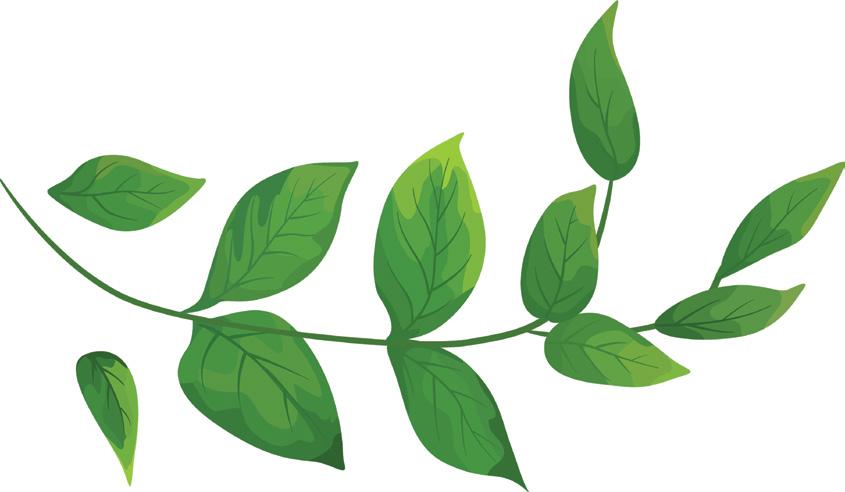
14 minute read
SAVING THE ENVIRONMENT
The Hudson County Chapter of the Native Plant Society of New Jersey
Story by Daniel Israel Photos by Lorraine Freeney
Advertisement
Kim Correro, Dawn Giambalvo and Lorraine Freeney are the coleaders of the Hudson County Chapter of the statewide nonprofi t Native Plant Society of New Jersey (NPSNJ). The three Jersey City residents are on a mission to educate locals about the benefi ts of native plants and provide access to them across the county.
Speaking with Jersey City Magazine, Kim and Dawn stressed the importance of native plants in the environment. Planting foliage whose native habitat is Hudson County is highly benefi cial for a number of reasons, primarily helping wildlife and even other plants.
“Native plants are the plants that have adapted to our local conditions and our local fl ora,” Kim said. “They are important because they provide sustenance to our local birds, butterfl ies and other pollinators. If we don’t have these plants to provide them with the food and the nourishment that they need, then we won’t have pollinators to pollinate our other gardens, our vegetable gardens and our crops.”
Native plants serve as a highway for nature on top of providing sustenance. The native fauna and fl ora allow for the easier migration of a number of species, including birds and insects, among other wildlife.
“Native plants provide a way for wildlife to travel through, past and around our area,” Dawn said. “We’re on two diff erent fl yways, with that intersection making New Jersey one of the birding capitals of the world. People forget that this is what’s going on. The natural world is doing its thing, it’s moving and grooving. And if we add native plants wherever we possibly can, even in little curb strips, or in pots on patios in front of someone’s stoop, those become microhabitats. When you link all these microhabitats together, it allows insects, birds and other wildlife to migrate naturally through the area. So it’s more than just plants, it’s a highway.”
Affecting the local ecosystem throughout Hudson County
Native plants also have more seeds, meaning they will provide that sustenance for wildlife more so than non-native plants. The native greenery also needs less care, making them easy to take care of, especially in an urban environment such as Jersey City. “They require less water, less maintenance and no chemicals,” Dawn said. “You don’t have to hire someone to go out in your yard and spray fungicides, herbicides or pesticides. Native plants have the deepest roots, they support more insects and wildlife, they absorb tons of stormwater to help mitigate fl ooding, and they help ward off the effects of climate change. They sequester a ton of carbon, even more so than trees. It’s not just hip or cute to plant native plants, it’s necessary.”
The planting of non-native plants is already aff ecting the local ecosystem throughout Hudson County. Kim and Dawn highlighted that every plant can make a diff erence.
“Hudson County is very densely populated,” Kim said. “There’s a lot of development in about every area of the county. The plants are losing this very important battle to all of the development that’s going up. Development is great, but we’re losing our trees and our plants. Because of that, we’re losing our bird population. And we just heard that the Monarch caterpillar is now on the endangered species list.”
Availability of native plants in Hudson County
While native plants are wonderful for the environment for a number of reasons, they are not easy to come by. As such, the Hudson County Chapter of the NPSNJ holds two plant sales each year to ensure native plants are readily available for residents across the county.
“The sales are very special because the closest native plant nursery is like an hourand-a-half drive away,” Kim said. “Native plants are so hard to access here.”
At the sales, there are experts from fields related to native plants. Dawn said this ranges from composters to nursery growers.
“The plant sales that we have are at zero profit,” Dawn said. “This is purely a community service. It’s also educational. The vendors and people that are attending our plant sale coming up are at the height of their field. We have these people there because we want the average person to be able to approach them and ask questions. I tend to be one of the people that learns most through my human interactions and I feel like this is an opportunity for people to just walk up and get a primer very quickly on the importance of native plants.”
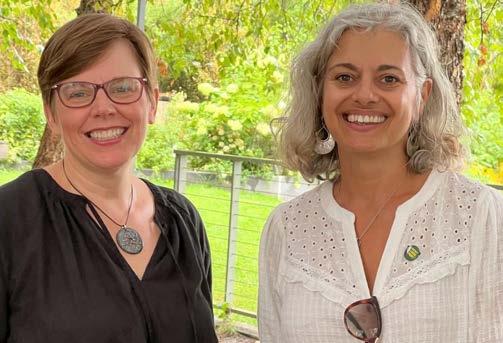
Ann and Dawn
Photo by Lorranine Freeney
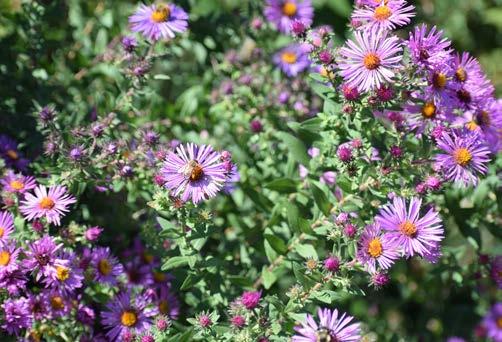
Photo by Lorranine Freeney
For those who didn’t catch the fall plant sale, there will be another in the spring, although
the fall is the best time to shop for and plant native plants.
“We aim to do two major plant sales a year,” Kim said. “We have one in the spring, but the most important one is in the fall. It’s important for people to understand what a good time of the year it is to start planting and do the majority of your planting.”
“Most of us think about planting in the spring because flowers are blooming and we’re excited to be outside after a long winter, but fall is an important planting time.” Dawn said. “That’s why this is an even more important plant sale than the spring one. When native plants are planted in the fall, it’s a special time because the temperatures are a little cooler, so there’s less of a stressor on plants. If you plant earlier in the year, it gets hot here very quickly and some plants have to struggle through the dry summer wind. But planting in the fall, it sort of eases the plants into the ground. And I think they just have an easier time of it. In fall, the native plants are able to make those deep roots and connections. They grow throughout the fall up until really cold snap temperature. And with climate change, we don’t have these super-cold temperatures until the middle of December into January.” Major projects ongoing in Jersey City and Secaucus
Native plants are not only hard to acquire, so is land dedicated to plant them. In addition to getting native plants in the hands and yards of residents, the organization is working with municipalities on getting them into parks. The Hudson County Chapter has worked with Jersey City and local organizations focusing on pollinator paths and other endeavors in Lincoln Park.
“One of our goals is to create greenways throughout Hudson County, not just for people to walk on, but for animals to migrate,” Dawn said. “Jersey City has the capability of becoming a pollinator city one day soon. It’s just starting to be on the radar.”
In Lincoln Park West, the group has been focusing on restoring wildlife and the forest there. Work has been ongoing since last year, with more work to be done, but signs of progress are already showing.
“Our chapter has really concentrated on large projects,” Kim said. “For the project in Lincoln Park, we’re working with the Friends of Lincoln Park on the West Side to restore the habitat. It has really been taken over by invasive plant species. It’s a big project, but we have a lot of help. We’re now a year into it, and it’s beautiful to see what we’ve accomplished. But there’s still a really long way to go and a lot of work to do.”
Outside of Jersey City, the group is working on a new park with Secaucus known as the Imagine Garden. Hudson Regional Hospital is across the street diagonally, so the town’s concept was to create a space for people either visiting someone in the hospital or admitted there to go and sit with their loved ones.
“It was last May or even earlier than that, when they said: ‘We have this ballfield. Would you like to make a park out of it?,’” Dawn said. “So we had the opportunity to turn an old, empty soccer field into this beautiful ecological park that is wheelchair accessible. It’s become this magnificent project.”
Amid the many native plant gardens at the park, there will also be 50 vegetable garden beds, and a sensory garden. In addition, the park will feature wheelchair accessibility,
pervious paths and rain gardens to absorb stormwater, and places of respite in the park to encourage community interaction, all courtesy of local NPSNJ volunteers.
“It’s amazing to see how far it’s come, but also how far we still have to go with it,” Kim said. “One thing about native plants is you put them in the ground, and sometimes they take a year or two to really establish. So we are a year in, and I really look forward to seeing what happens now in this next stage.”
More fall plantings are slated for the gardens in the coming weeks, as native plants are now being delivered to the park. The hope is that these endeavors by the NPSNJ will spark interest and more initiatives in the future.
“The big projects are hopefully going to encourage smaller projects,” Kim said. “We already do a lot of work with schools, we volunteer with Girl Scouts, and we’re hopefully going to be doing something with the Boys and Girls Club this fall. Wherever we can provide that education and whoever is willing to listen, then we are going to be there.”
Poetry series and webinar offerings, too
Outside of the plant sales and park projects and other events across the different municipalities, the Hudson County Chapter of the NPSNJ has also launched a weekly poetry series with a Jersey City poet. Known as Saturday Morning Poetry with Ann Wallace, the idea grew from Kim initially posting a single poem by Ann on the NPSNJ’s Instagram. Follow them at @ kimcorrero and @annwallace409.
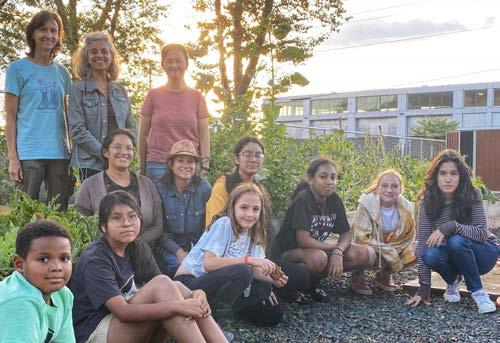
Photo by Lorranine Freeney
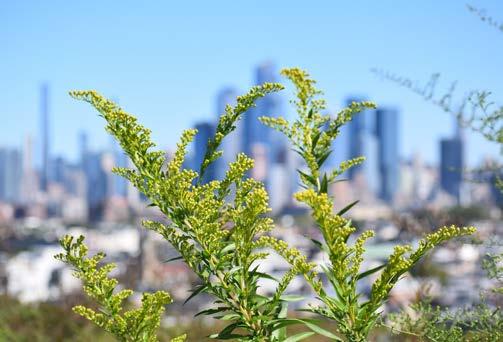
Photo by Lorranine Freeney
“It started in the early summer because I’m a poet and Kim asked to share one of my poems,” Ann said. “Then she wanted to share another. Then we thought, well, there’s so much poetry out there, and
then at the same time Ada LimÓn was appointed the Poet Laureate of the United States. She writes a lot about nature and wildlife and native plants, so that week I told Kim that I wanted to post this poem by Ada Limon. Once we did that, the wheels started turning for both of us, that we wanted to bring in a different poet and a different poem every week. That’s what happened, and we just ran with it.”
Ann used her connections to poets across the country to bring in new material to post on the NPSNJ’s Instagram page. Soon, the posts turned into Instagram Live poetry readings every Saturday.
“We’ve had a few Jersey poets, but we’ve had people from all over the country who’ve sent in their work,” Ann said. “We posted it, and then early on I decided to read one of the poems on Instagram Live. Then Kim suggested we invite the poet to have a reading and interview with me on Instagram Live. So it evolved very organically. We just started small with one poem on a day, like one of my poems on Saturday, and then we just built from there and kept thinking bigger and bigger. It’s now become this weekly feature. By the time we’re going to be wrapping up mid-October, we will have had 12 different guest poets for Saturday morning poetry, each with an Instagram Live or Zoom interview.”
According to Ann, the readings also include interviews with each poet afterward. Guests included: Ross Gay, Maggie Smith, Julie Zickefoose, Rachel Mackow, Theta Pavis, Thomas E. Frank, Barbara Kingsolver and Lili Taylor. Season one has ended, with the videos still available to watch on Instagram, and season two is planned for the spring. Dawn
“It’s not so much an interview as a reading by the poet and then a conversation,” Ann said.” These conversations have been really very rich, and in some cases complex, but they’re also just reflective. We slow down and we listen to a poem together. How many times do people get on social media and listen to poetry? Not that often. So this invites people to slow down, stop, listen, think, and then also take those ideas home with them and out into the world.”
Ann said the poems all revolve around nature, but from the perspectives of different authors in different environments from urbanites to farmers. Nature has had a profound impact on many poets, and the series aims to highlight that and demonstrate that native plants are an important aspect of that.
“One of the things that keeps coming up again and again in these conversations is about walking, observing and getting out into your environment,” Ann said. “Every poet has been a keen observer of their environment, whether they’re a native plant gardener, or a birdwatcher, or just a person who may be a parent who’s watching their kids grow up and seeing that reflected in the life cycle of the birds or the plants around them. The metaphors that nature holds are rich and meaningful. That’s what we’re
trying to invite people to experience with us.”
Another effort undertaken by the Hudson County Chapter of the NPSNJ was participation in the Hudson Gives campaign back in May to help fundraise for more native plantings. The local chapter helped raise funds to plant native greenery in 10 projects at school gardens, public gardens, parks and more.
Join the NPSNJ for just $20 annually
The “mini-grants” were awarded by the Hudson County Chapter to other organizations and people who are restoring small patches of land in their communities. Some projects included planting native flora and fauna at Triangle Park in Greenville and West Slope Community Gardens in the Heights, which the co-leaders personally attended to get their hands dirty helping to plant.
“We’re not just ladies who have lunch or anything like that,” Dawn said. “We actually get dirty. We get filthy and dig and work really hard. It’s all worth it.”
In addition there are also online webinars hosted frequently by the NPSNJ. For more information, go online to npsnj.org.
“The Native Plant Society of New Jersey has an incredible webinar series started during the pandemic,” Kim said. “It’s a bunch of chapters Lorraine coming together and we have some of the top leaders of scientists, botanists and entomologists that come on and talk to us. Hundreds of people watch and attend these webinars for the advice.”
Kim noted that all of the benefits of being a member of the NPSNJ come at an affordable price. She said that membership offers residents the ability to continue to learn about native plants and help promote them in the area, as well as any other chapter they so desire.
“For $20 a year, you have access to our incredible team of scientists, you can go to all our events if you want to, you can get onto our webinar series for free,” Kim said. “All of the other organizations are fantastic, but we’re the only organization that I’ve come across where they don’t charge more than that to give all of these services. Even when you volunteer at one of our events, you’re learning and that is what people come for. We give away a lot of pizza, too, most of the time, but the chance to be around these other people who know about the plants and how they’re changing our world is what people come out for.”
Together, the Hudson County Chapter aims to save the environment one plant at a time. For more information, email Hudson@npsnj.org or follow them on Instagram at @npsnjhudsoncounty.
Kim confirmed: “One of our primary functions as a chapter is being able to resource the plants and bring them to the people. They are hard to get to. You have to drive pretty far from Jersey City and Hudson County to go to a native plant nursery. So educating people, broadening our audience through poetry, and in some cases art, is really important. Having these different verticals, I think, sets the Hudson County Chapter of the Native Plant Society of New Jersey apart.” — JCM

Photo by Lorranine Freeney

Photo by Lorranine Freeney

Photo by Lorranine Freeney

Photo by Lorranine Freeney








